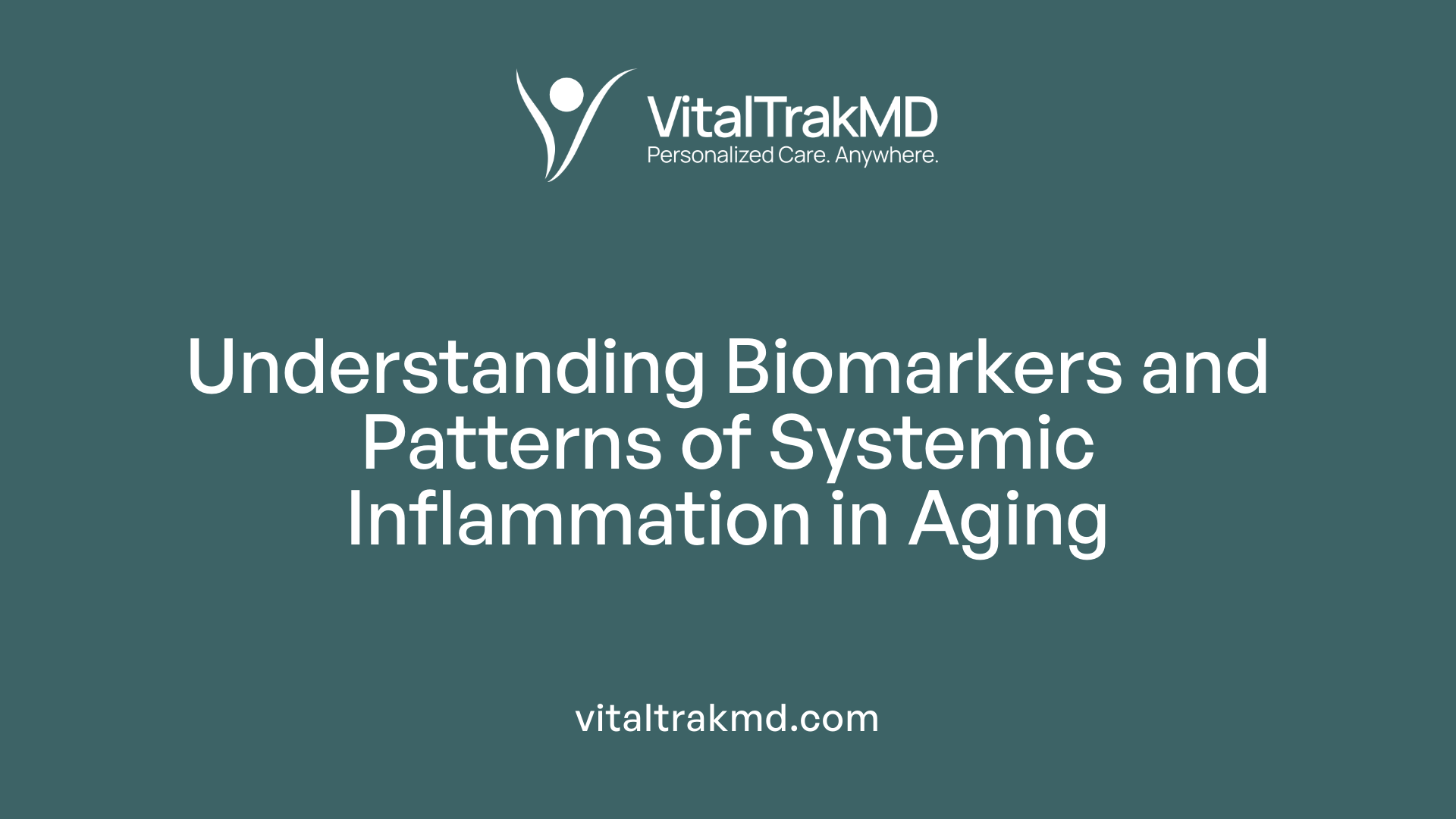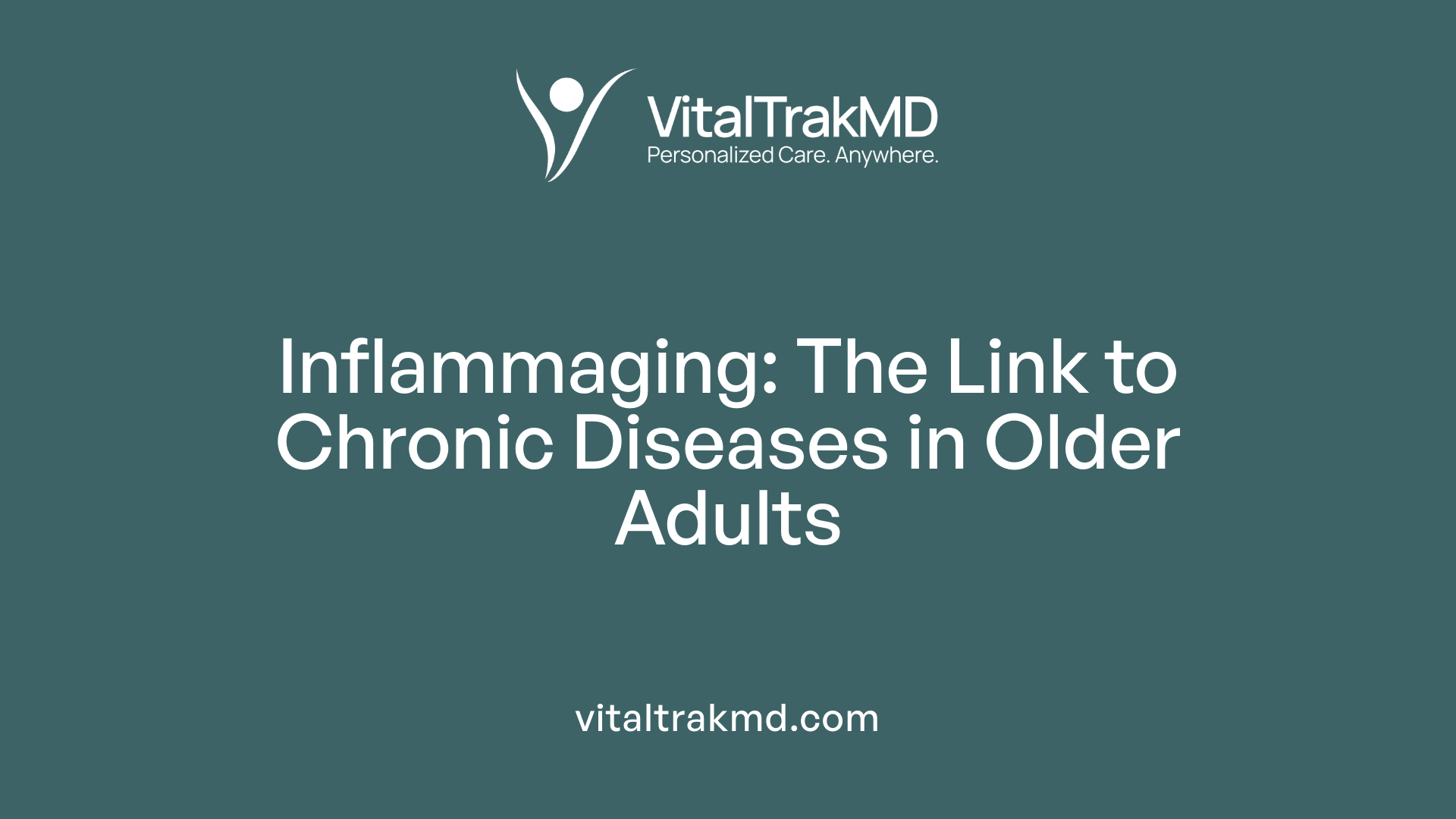Inflammation’s Impact and Its Link to Chronic Diseases in Seniors

Understanding Inflammaging and Its Consequences
As individuals age, their bodies undergo complex biological changes that predispose them to a range of chronic health conditions. Central to this process is a phenomenon known as inflammaging, which involves persistent, low-grade systemic inflammation. This article explores the mechanisms behind inflammaging, its contribution to age-related diseases, and potential interventions to mitigate its impact.
The Biology of Inflammaging: Cellular and Molecular Foundations

What biological mechanisms link inflammation to aging and chronic diseases in seniors?
Inflammaging is the term used to describe the low-grade, chronic inflammation that develops as part of the natural aging process. This persistent inflammation is driven by a complex interplay of cellular and molecular mechanisms.
A key contributor is cellular senescence, a state where cells permanently stop dividing due to damage or stress. Senescent cells secrete a mixture of inflammatory molecules known as the senescence-associated secretory phenotype (SASP). These include cytokines like IL-6, TNF-α, and IL-1β, chemokines, and proteases that promote tissue inflammation.
The SASP not only increases inflammation but also induces senescence in neighboring cells, creating a vicious cycle. This accumulation of senescent cells and their inflammatory products damages tissues and impairs cellular function.
On a molecular level, the NF-κB signaling pathway plays a prominent role. It becomes increasingly active with age, leading to enhanced production of inflammatory cytokines. NF-κB acts as a central regulator of immune and inflammatory responses, but when chronically activated, it contributes to tissue degeneration.
Inflammasomes, which are multiprotein complexes involved in activating inflammatory responses, also become dysregulated during aging. Their activation results in the release of cytokines such as IL-1β and IL-18, further fueling systemic inflammation.
Endoplasmic reticulum (ER) stress is another factor linked to inflammaging. As cells accumulate damage and misfolded proteins with age, ER stress activates inflammatory pathways, aggravating immune responses.
These processes are interconnected and feed into each other, creating a sustained inflammatory environment. Such chronic inflammation affects organs and tissues, leading to diseases like atherosclerosis, neurodegeneration, diabetes, and cancer.
Overall, the molecular and cellular mechanisms—ranging from cellular senescence and SASP to NF-κB pathway activation, inflammasomes, and ER stress—form the biological core of inflammaging, illustrating how inflammation accelerates aging and age-related health decline.
Inflammaging and Systemic Inflammation: Patterns and Biomarkers
 As individuals age, their bodies often exhibit a persistent, low-grade state of inflammation known as inflammaging. This chronic inflammatory condition is characterized by elevated levels of molecules such as C-reactive protein (CRP), interleukin-6 (IL-6), and tumor necrosis factor-alpha (TNF-α). These inflammatory markers serve as vital indicators of systemic inflammation and are strongly linked to the development of age-related diseases like cardiovascular conditions, neurodegenerative disorders, and metabolic syndromes.
As individuals age, their bodies often exhibit a persistent, low-grade state of inflammation known as inflammaging. This chronic inflammatory condition is characterized by elevated levels of molecules such as C-reactive protein (CRP), interleukin-6 (IL-6), and tumor necrosis factor-alpha (TNF-α). These inflammatory markers serve as vital indicators of systemic inflammation and are strongly linked to the development of age-related diseases like cardiovascular conditions, neurodegenerative disorders, and metabolic syndromes.
The activation of specific molecular pathways, including the NLRP3 inflammasome, p38 MAPK, and mTOR, fuels the inflammatory process during aging. Biomarkers such as IL-1 and IL-18 further reflect the ongoing immune response, while alterations in adaptive immunity, notably the accumulation of senescent T cells and macrophages secreting SASP (senescence-associated secretory phenotype), amplify inflammation and immune deterioration.
In different populations, patterns of inflammaging vary. Studies from affluent countries report increasing inflammatory markers with age, correlating with higher incidences of chronic diseases. Conversely, indigenous populations with high infectious burdens, like the Tsimane or Orang Asli, do not show a rise in inflammation as they age, suggesting environmental factors heavily influence inflammaging.
The gut microbiota also plays a crucial role. Age-associated dysbiosis, with reduced microbial diversity and an increase in pro-inflammatory bacteria, contributes to immune activation through the release of damage-associated molecular patterns (DAMPs). These DAMPs, derived from damaged cells and mitochondria, activate innate immune pathways, further perpetuating inflammation.
In summary, inflammaging involves interconnected pathways and biomarkers including cytokines (IL-6, TNF-α), inflammatory proteins (CRP), and DAMP-related signals. Understanding these patterns helps in developing targeted interventions to modulate immune responses and potentially delay age-related functional decline.
The Impact of Inflammaging on Age-Related Diseases

What is the relationship between inflammation and chronic disease development?
Chronic inflammation is a fundamental factor in the onset and progression of many age-related illnesses. Unlike the brief, protective response that occurs during acute inflammation, persistent low-grade inflammation—often called inflammaging—continues over months or years without resolving. This ongoing state causes continuous tissue damage and alters cellular functions, thus fostering conditions like cardiovascular diseases, neurodegenerative disorders, diabetes, and even certain cancers.
Various triggers, such as unhealthy diets, obesity, chronic infections, oxidative stress, and environmental toxins, can sustain this inflammatory state. For example, increased levels of cytokines like IL-6, TNF-α, and IL-1β are commonly observed in aging tissues and circulation. These cytokines contribute to tissue deterioration, organ dysfunction, and immune dysregulation.
Managing inflammation is crucial in reducing these health risks. Lifestyle modifications, including balanced diets rich in anti-inflammatory foods, regular physical activity, stress reduction, and medical treatments like anti-inflammatory drugs or senolytics, are promising strategies. Overall, controlling inflammaging offers a promising approach to lower the burden of various diseases that impair health and quality of life in older adults.
How does inflammaging influence specific age-related diseases?
| Disease | Inflammatory Role | Specific Impact | Contributing Factors |
|---|---|---|---|
| Cardiovascular diseases | Elevated cytokines promote atherogenesis and plaque instability | Increased risk of heart attacks and strokes | Obesity, poor diet, smoking, sedentary lifestyle |
| Neurodegenerative disorders | Microglia and astrocytes become pro-inflammatory, affecting neurons | Alzheimer’s disease, cognitive decline | Microglial activation, oxidative stress |
| Type 2 diabetes | Inflammation impairs insulin signaling | Insulin resistance, metabolic syndrome | Obesity, diets high in refined carbs |
| Cancer | Chronic inflammation fosters cellular mutations and proliferation | Liver, pancreatic, colon, and other cancers | Infections, environmental toxins |
| Sarcopenia, osteoporosis, frailty | Inflammatory cytokines promote muscle and bone loss | Weakness, increased fracture risk | Sedentary lifestyle, poor nutrition |
Understanding the pathways linking inflammaging to these disorders highlights the importance of early intervention. Lifestyle measures like diet adjustments—favoring omega-3 fatty acids, antioxidants, and fiber—along with regular exercise, can help reduce systemic inflammation. Emerging therapies targeting senescent cells and immune regulation hold promise for mitigating these prevalent, debilitating conditions.
The Vicious Cycle: How Inflammaging Amplifies Aging Processes

What is inflammaging and how does it contribute to age-related health decline?
Inflammaging is a state of persistent, low-level inflammation that develops with age, often without clear infection or injury. It results from various factors including cellular senescence, immune system decline (immunosenescence), and changes in the microbiome. This constant inflammatory environment accelerates tissue and organ deterioration.
How does immunosenescence play a role?
As we age, our immune system's ability to respond effectively declines. The reduction in naive immune cells and the accumulation of senescent immune cells lead to increased secretion of pro-inflammatory molecules, known as SASP (senescence-associated secretory phenotype). This shift causes immune dysregulation, making the body less capable of clearing damaged cells and pathogens, fueling the inflammatory cycle.
Impact on organs: brain, heart, kidneys, lungs, and liver
Persistent inflammation affects multiple organs, causing structural and functional declines. In the brain, microglia and astrocytes become chronically activated, contributing to neurodegenerative diseases like Alzheimer's. In the heart and blood vessels, inflammaging promotes atherosclerosis, increasing cardiovascular risk. The kidneys and lungs also experience fibrosis and decreased function due to ongoing inflammation. The liver, a central metabolic organ, faces inflammation-driven damage which can lead to cirrhosis and metabolic disorders.
How does persistent inflammation cause organ damage?
Chronic inflammation triggers tissue damage through sustained release of cytokines and other inflammatory mediators. This process results in oxidative stress, cellular apoptosis, and fibrosis, impairing the organ’s original function. For instance, in the lungs, inflammation can cause stiffening and reduced gas exchange, while in the kidneys, it leads to decreased filtration capacity.
The role of senescent cells and SASP
Senescent cells accumulate with age and release a broad spectrum of inflammatory cytokines, chemokines, and enzymes as part of SASP. These secretions promote local and systemic inflammation, recruit immune cells, and influence neighboring cells to become senescent, creating a feedback loop that amplifies tissue deterioration.
Feedback loop: inflammation and senescence
This cycle is self-perpetuating: inflammation leads to increased cell stress and damage, prompting more cells to enter senescence. These senescent cells, in turn, secrete SASP factors that heighten inflammation further. Over time, this vicious feedback loop accelerates aging processes, organ decline, and susceptibility to age-related diseases.
Cellular Senescence and Its Role in Chronic Inflammation

What biological mechanisms link inflammation to aging and chronic diseases in seniors?
In aging populations, a sustained, low-level systemic inflammation—often called inflammaging—plays a significant role in the development of age-related diseases. Central to this process is the accumulation of senescent cells, which are damaged or exhausted cells that no longer divide but remain metabolically active.
Senescent cells secrete a complex mixture of inflammatory mediators known as the senescence-associated secretory phenotype (SASP). This includes cytokines such as IL-6, IL-1β, and TNF-α, chemokines, growth factors, and proteases. SASP factors promote tissue inflammation, alter cellular function, and can induce neighboring cells to become senescent, thereby propagating inflammation.
The effects of SASP extend to neighboring cells, creating a local environment that fosters further cellular damage and tissue dysfunction. In addition, chronic activation of the immune system occurs, driven by pathways like NF-κB, which upregulates inflammatory gene expression. This persistent immune activation not only damages tissues but also impairs immune responses—a condition known as immunosenescence.
Signaling pathways such as NF-κB, mTOR, and p38 MAPK are involved in triggering and perpetuating inflammation. Their chronic activation enhances SASP production and inflammatory responses, leading to organ decline. Furthermore, the build-up of senescent cells and sustained inflammation hinder the body's ability to clear damaged cells, intensifying tissue deterioration.
The combined effect of these mechanisms accelerates the aging process and fosters various chronic diseases, including cardiovascular diseases, neurodegeneration, diabetes, and cancers. Therapeutic strategies targeting senescent cells, called senolytics, are being explored to break this cycle, reduce inflammation, and promote healthier aging.
Strategies to Counteract Inflammaging: Lifestyle, Diet, and Emerging Therapies
What strategies and interventions to reduce or manage chronic inflammation in older adults?
Managing chronic, low-grade inflammation—often called inflammaging—is essential for healthy aging. Several approaches focus on lifestyle, diet, and emerging medical therapies.
One of the most effective strategies involves adopting an anti-inflammatory diet. The Mediterranean diet, rich in fruits, vegetables, whole grains, lean proteins, nuts, and olive oil, has been shown to lower systemic inflammation. Incorporating omega-3 fatty acids from fatty fish like salmon or mackerel and polyphenolic compounds found in berries, tea, and dark chocolate also helps reduce inflammatory markers like IL-6 and CRP.
Regular physical activity is another cornerstone. Engaging in brisk walking, swimming, cycling, strength training, or yoga not only promotes cardiovascular and muscular health but also decreases inflammation biomarkers. Exercise improves immune function, reduces visceral fat, and encourages the production of anti-inflammatory cytokines.
Medical interventions are expanding beyond lifestyle changes. Pharmacological options like anti-inflammatory drugs, including NSAIDs, are sometimes used but with caution due to potential side effects. Emerging therapies such as senolytics — drugs that selectively eliminate senescent cells — are promising in reducing SASP-driven inflammation.
Another innovative area involves modulating gut microbiota. Since age-related changes in microbiome diversity can promote inflammation, probiotics, prebiotics, and dietary fibers aim to restore healthy microbial balance, which can, in turn, dampen inflammatory responses.
Combining these strategies involves coordinated efforts of diet, exercise, medical management, and stress reduction. Regular health screening and consults with healthcare providers help tailor interventions.
In summary, a holistic approach that emphasizes a healthy diet, active lifestyle, and emerging therapies presents a viable pathway to managing inflammaging, thereby reducing the risk of age-related chronic diseases.
The Socioeconomic and Ecological Dimensions of Inflammation in Aging
How does inflammation increase with age and what role does it play in age-related diseases?
Inflammation generally tends to rise as people grow older, especially in industrialized countries. This chronic, low-level inflammation, called inflammaging, is linked to many aging-related health issues like Alzheimer’s disease, diabetes, and heart conditions. It results from the accumulation of inflammatory markers such as IL-6, CRP, and TNF-α in the bloodstream, which can damage tissues and organs over time.
However, recent research indicates that this pattern isn’t the same across all populations. Studies involving indigenous groups such as the Tsimane in Bolivia and the Orang Asli in Malaysia have shown that inflammation levels do not necessarily increase with age in these communities. Even in older adults, levels of inflammatory markers remain low and don’t correlate with the prevalence of age-related diseases.
This variation suggests that lifestyle, environment, and development play a significant role in inflammation. In highly developed, industrialized settings, factors like poor diet, sedentary habits, pollution, and increased exposure to chronic infections contribute to heightened inflammation. Conversely, in less developed areas with high infectious burdens, the immune system adapts differently, often maintaining lower levels of inflammatory activity despite aging.
Therefore, the link between inflammation and age-related diseases might be partly modifiable. Interventions such as healthy diets rich in anti-inflammatory foods, regular physical activity, and reducing exposure to pollutants could help manage inflammaging. Understanding these ecological influences allows for more targeted public health strategies to promote healthy aging, emphasizing that inflammaging is not an inevitable consequence of aging but can be influenced by the environment and lifestyle.
Implementing a Multi-Modal Approach to Manage Inflammaging and Extend Healthspan
What interventions like lifestyle changes, anti-inflammatory drugs, senolytics, immune cell therapies, stem cell therapies, and organ transplants are being researched to mitigate inflammaging and age-related diseases?
Research into combating inflammaging involves several promising strategies. Among them, senolytic therapies aim to eliminate senescent cells that contribute to chronic inflammation through the secretion of inflammatory factors, known as SASP. These therapies show potential to reduce systemic inflammation and improve tissue function.
Diet plays a crucial role as well. Studies indicate that diets rich in anti-inflammatory foods—such as fruits, leafy greens, fatty fish, nuts, and olive oil—can lower inflammation markers like CRP, IL-6, and TNF-α. Conversely, diets with high DII scores, reflecting increased pro-inflammatory foods, are linked to higher risks of cardiovascular disease, diabetes, hypertension, and the accumulation of multiple chronic conditions.
Medical advancements also include exploring immune cell therapies, stem cell therapies, and even organ transplants. These are designed to restore or replace damaged tissues and bolster immune responses, addressing age-related organ decline and systemic inflammation. However, many of these approaches are still in experimental stages, requiring further research.
Complementing biological interventions, close monitoring of inflammation markers—such as CRP, IL-6, and specific microRNAs—is vital for personalized treatment plans. This enables healthcare providers to track the effectiveness of interventions and adjust strategies accordingly.
Overall, combining lifestyle modifications, targeted medical treatments, and regular biomarker assessment forms a comprehensive approach to mitigating inflammaging and enhancing healthy aging.
Harnessing Knowledge to Improve Aging Outcomes
In summary, inflammaging significantly influences the pathogenesis of numerous age-related chronic diseases, yet its presence is modifiable through lifestyle, diet, and emerging therapies. Recognizing the molecular and systemic pathways involved allows for targeted interventions aimed at delaying aging processes and improving healthspan. Continued research and personalized approaches will be essential in translating these insights into effective strategies, ultimately fostering healthier, more resilient aging populations.
References
- Redefining Chronic Inflammation in Aging and Age-Related Diseases
- Chronic Inflammation and Its Impact on Aging
- Inflammation and aging: signaling pathways and intervention ...
- Aging and chronic inflammation: highlights from a multidisciplinary ...
- Elevated Inflammatory Status and Increased Risk of Chronic ...
- The role of inflammation in age-related disease - Aging-US
- Three common assumptions about inflammation, aging, and health ...
- Inflammation, ageing and chronic disease - ScienceDirect.com
- Aging-Related Inflammation Is Not Universal Across Human ...
- Aging: Chronic inflammation is associated with industrialized lifestyles
Recent articles
Want to Feel Better and Live Healthier?
Join hundreds of patients taking control of their health with personalized care that fits their life – not the other way around.
Rated 4.8/5 by 32+ customers







